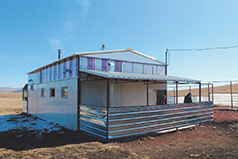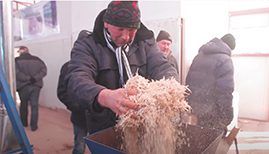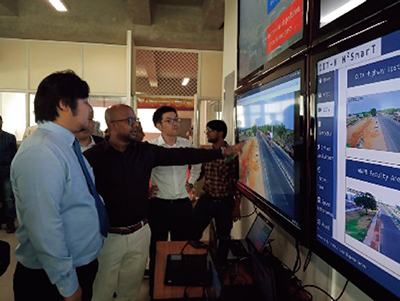(10) Science, Technology, and Innovation (STI) for SDGs
In the world today, progress in science and technology, as represented by artificial intelligence (AI) and robotics, leads to social changes and underpins economic growth through utilization of information technology and information and communication technology (ICT) Note 45 in diverse industries, including not only the manufacturing industry and the service industry but also agriculture and construction.
Based on the 2030 Agenda for Sustainable Development (Paragraph 70), the UN has established the United Nations Inter-agency Task Team on STI for the SDGs (UN-IATT) and promotes STI for the SDGs on a global scale, with cooperation by various countries. In addition, the United Nations Multi-Stakeholder Forum on Science, Technology and Innovation for the Sustainable Development Goals (STI Forum) has been held annually since 2016. Furthermore, the Political Declaration of the SDG Summit adopted in September 2019 mentions the commitment to harnessing STI with a greater focus on digital transformation for sustainable development. As can be seen from these efforts, there are increasing international expectations for STI as a key to contribute to realizing the SDGs by fully utilizing limited resources.
Georgia
Project for Establishment of Bio-Briquettes Workshop Facility for Two Villages in Tsalka Municipality Grant Assistance for Grass-Roots Human Security Projects (February 2019 – February 2020)

The bio-briquette production facility constructed through this project

Producing bio-briquettes
Tsalka Municipality in Georgia is located approximately 100 kilometers west of the capital of Tbilisi. This municipality is one of the most ethnically diverse areas in the country, where Armenian, Azerbaijani, and Greek ethnic groups live, including people forced to migrate from the mountainous part of western Georgia due to natural disasters and internally displaced persons due to conflicts. It is also known for its harsh, cold winters, and is sometimes called the “Siberia of Georgia”. Since only a limited variety of crops can be produced in the area, many of the people there are living in poverty.
In Tsalka Municipality, firewood stoves are still used because gas supply is not widely available. It is said that a single household uses as much as approximately 1 to 1.5 tons of firewood per year in order to survive the long and harsh winter. However, many poor households in the municipality cannot afford the cost of firewood, and illegal cases of logging have been reported. Concerns have also been raised about the negative impact of logging on disaster prevention, as the trees in the area were originally planted as windbreak forests.
In response to this situation, Japan supported the construction of facilities to produce processed firewood, called bio-briquettes, in two villages in the municipality through the local NGO “BRIDGE – Innovation and Development”. Bio-briquettes are cheaper than firewood because they are made from existing scrap wood residue from local peoples’ living spaces, such as chips from forest thinning and sawdust. These facilities will enable approximately 200 households (approximately 1,000 people) to use bio-briquettes, which is expected to curb logging by the local people and protect the environment in surrounding areas.
●Japan’s Efforts

A Japan-India joint research project (the Project for Smart Cities for Emerging Countries based on Sensing, Network and Big Data Analysis of Multimodal Regional Transport System) carried out at the Indian Institute of Technology Hyderabad (Photo: JICA)
In the process of its economic development so far, Japan has overcome its own challenges in fields such as health and medical care, environment, and disaster risk reduction while fully utilizing STI. Based on these experiences, Japan has been engaging in cooperation of science and technology to resolve challenges faced by developing countries through the Science and Technology Research Partnership for Sustainable Development (SATREPS) and others in recent years (see “Glossary” for details on SATREPS). The promotion of the use of geothermal power, which contributes to the realization of a low-carbon society, through the development of geothermal exploration technology in Indonesia and the identification of lead contamination mechanisms and the development of technologies for prevention/environmental remediation in Zambia are good examples of problem-solving through SATREPS (see “Master Techniques from Japan to the World” for details on specific initiatives of SATREPS).
In December 2015, as a part of the Science and Technology Diplomacy Advisory Network utilized in the process of planning and formulating various diplomatic policies including Japan’s diplomacy and international conferences, the Advisory Board for Promoting Science and Technology Diplomacy was established and composed of academic experts in fields related to science and technology diplomacy. In May 2017, the Advisory Board released the Recommendation for the Future (STI as a Bridging Force to Provide Solutions for Global Issues) regarding specific science and technology diplomacy initiatives on implementing the SDGs, and in May 2018, released the Recommendation on Science, Technology and Innovation (STI) Roadmap for the achievement of the SDGs.
Based on these two recommendations, at the G20 Osaka Summit in 2019, the importance of STI was recognized, as well as the need for effective participation by various stakeholders, including governments, academia, research institutions, civil society, the private sector, and international organizations in harnessing the potential of STI. As a result, the Guiding Principles for the Development of Science, Technology, and Innovation (STI) for SDGs Roadmaps, formulated by the G20 Development Working Group, were endorsed as an Annex of the G20 Osaka Leaders’ Declaration.
Alongside this, in order to encourage countries around the world to consider formulating roadmaps, the UN-IATT began an initiative known as the Global Pilot Programme and chose five countries – Ethiopia, Ghana, Kenya, India, and Serbia – to be the first pilot countries. In order to support these five countries, in cooperation with the European Union (EU) and international organizations, Japan has begun assisting particularly Kenya and India in formulating and implementing roadmaps starting from FY2020.
In addition, at TICAD7, based on the content of the Recommendations towards TICAD7: Achieving an Innovation Ecosystem together with Africa, submitted by the Advisory Board for the Promotion of Science and Technology Diplomacy, Japan contributed to discussions for promoting practical implementation of the results of international joint research and R&D with cooperation of international organizations toward STI for the SDGs. Moreover, the Yokohama Declaration 2019, adopted as the outcome document of TICAD7, also recognizes the important role of STI.
Furthermore, Japan is advancing efforts toward the establishment of the “STI for SDGs Platform,” a platform to promote the use of Japan’s advanced science and technology that can contribute to helping developing countries and others achieve the SDGs.
Japan will continue to make use of the high potential of STI and actively participate in initiatives of the international community toward resolving the extensive global issues raised by the SDGs, including climate change, changes in marine environments, reduction of biodiversity, issues with food and water resources, infectious diseases, and disasters.
- Note 45: See Note 8.
